Asus X2048 User Manual
GigaX2024/2048
Layer 2 Managed Switch
User Manual
E2301
October 2005 V2.3
Copyright © 2005 ASUSTeK COMPUTER INC. All Rights Reserved. No part of this manual, including the products and software described in it, may be reproduced, transmitted, transcribed, stored in a retrieval system, or translated into any language in any form or by any means, except documentation kept by the purchaser for backup purposes, without the express written permission of ASUSTeK COMPUTER INC. (ASUS).
Product warranty or service will not be extended if: (1) the product is repaired, modified or altered, unless such repair, modification of alteration is authorized in writing by ASUS; or (2) the serial number of the product is defaced or missing.
ASUS provides this manual “as is” without warranty of any kind, either express or implied, including but not limited to the implied warranties or conditions of merchantability or fitness for a particular purpose. In no event shall ASUS,
its directors, officers, employees, or agents be liable for any indirect, special, incidental, or consequential damages (including damages for loss of profits, loss of business, loss of use or data, interruption of business and the like), even if ASUS has been advised of the possibility of such damages arising from any defect or error in this manual or product.
Specifications and information contained in this manual are furnished for informational use only, and are subject to change at any time without notice, and should not be construed as a commitment by ASUS. ASUS assumes no responsibility or liability for any errors or inaccuracies that may appear in this manual, including the products and software described in it.
Products and corporate names appearing in this manual may or may not be registered trademarks or copyrights of their respective companies, and are used only for identification or explanation and to the ownersʼ benefit, without intent to infringe.

GigaX2024/2048 L2 Managed SwitchUser Manual
Federal Communications Commission Statement
This device complies with Part 15 of the FCC Rules. Operation is subject to the following two conditions:
•This device may not cause harmful interference, and
•This device must accept any interference received including interference that may cause undesired operation.
This equipment has been tested and found to comply with the limits for a Class B digital device, pursuant to Part 15 of the FCC Rules. These limits are designed to provide reasonable protection against harmful interference in a residential installation. This equipment generates, uses and can radiate radio frequency energy and, if not installed and used in accordance with manufacturerʼs instructions, may cause harmful interference to radio communications. However, there is no guarantee that interference will not occur in a particular installation. If this equipment does cause harmful interference to radio or television reception, which can be determined by turning the equipment off and on, the user is encouraged to try to correct the interference by one or more of the following measures:
•Reorient or relocate the receiving antenna.
•Increase the separation between the equipment and receiver.
•Connect the equipment to an outlet on a circuit different from that to which the receiver is connected.
•Consult the dealer or an experienced radio/TV technician for help.
WARNING! The use of shielded cables for connection of the monitor to the graphics card is required to assure compliance with FCC regulations. Changes or modifications to this unit not expressly approved by the party responsible for compliance could void the userʼs authority to operate this equipment.
Canadian Department of Communications Statement
This digital apparatus does not exceed the Class B limits for radio noise emissions from digital apparatus set out in the Radio Interference Regulations of the Canadian Department of Communications.
This class B digital apparatus complies with Canadian ICES-003.
i

GigaX2024/2048 L2 Managed Switch User Manual
ASUS contact information
ASUSTeK COMPUTER INC. (Asia-Pacific)
Address: |
150 Li-Te Road, Peitou, Taipei, Taiwan |
General Tel: |
+886-2-2894-3447 |
General Fax: |
+886-2-2894-7798 |
Web Site: |
www.asus.com.tw |
Technical Support |
|
MB/Others (Tel): |
+886-2-2890-7121 (English) |
Notebook (Tel): |
+886-2-2890-7122 (English) |
Desktop/Server (Tel): |
+886-2-2890-7123 (English) |
Support Fax: |
+886-2-2890-7698 |
ASUS COMPUTER INTERNATIONAL (America)
Address: |
44370 Nobel Drive, Fremont, CA 94538, USA |
General Fax: |
+1-502-933-8713 |
General Email: |
tmd1@asus.com |
Web Site: |
usa.asus.com |
Technical Support |
|
Support Fax: |
+1-502-933-8713 |
General Support: |
+1-502-995-0883 |
Notebook Support: |
+1-510-739-3777 x5110 |
Support Email: |
tsd@asus.com |
ASUS COMPUTER GmbH (Germany and Austria)
Address: |
Harkort Str. 25, D-40880 Ratingen, BRD, Germany |
|
General Fax: |
+49-2102-9599-31 |
|
General Email: |
sales@asuscom.de (for marketing requests only) |
|
Technical Support |
|
|
Support Hotlines: |
(Components) |
+49-2102-95990 |
|
(Notebook PC) |
+49-2102-959910 |
Support Fax: |
+49-2102-959911 |
|
Support Email: |
www.asuscom.de/de/support (for online support) |
|
Web Site: |
www.asuscom.de |
|
ASUS COMPUTER (Middle East and North Africa)
Address: |
P.O. Box 64133, Dubai, U.A.E. |
General Tel.: |
+9714-283-1774 |
General Fax: |
+9714-283-1775 |
General Email: |
www.ASUSarabia.com |
ii

GigaX2024/2048 L2 Managed SwitchUser Manual
Table of Contents
1 Introduction.............................................................................. |
1 |
||
1.1 |
GigaX2024/2048 features........................................................... |
1 |
|
1.2 |
Conventions used in this document ........................................... |
2 |
|
|
1.2.1 |
Notations ........................................................................................ |
2 |
|
1.2.2 Typography..................................................................................... |
2 |
|
|
1.2.3 Symbols.......................................................................................... |
2 |
|
2 Getting to know the GigaX...................................................... |
3 |
||
2.1 |
Package contents ....................................................................... |
3 |
|
2.2 |
Front Panel.................................................................................. |
4 |
|
2.3 |
Rear Panel.................................................................................. |
5 |
|
2.4 |
Technical specifications............................................................... |
5 |
|
3 Quick start guide..................................................................... |
6 |
||
3.1 |
Part 1 — Installing the hardware.................................................. |
6 |
|
|
3.1.1 |
Installing the switch on a flat surface.............................................. |
6 |
|
3.1.2 |
Mounting the switch on a rack........................................................ |
6 |
3.2 |
Part 2 — Setting up the switch..................................................... |
6 |
|
|
3.2.1 |
Connect the console port................................................................ |
6 |
|
3.2.2 Connect to the computers or a LAN............................................... |
7 |
|
|
3.2.3 Attach the RPS module ................................................................. |
7 |
|
|
3.2.4 Attach the power adapter ............................................................... |
7 |
|
3.3 |
Part 3 — Basic switch setting for management ........................... |
8 |
|
|
3.3.1 |
Setting up through the console port ............................................... |
8 |
|
3.3.2 |
Setting up through the Web interface............................................. |
9 |
4 Management with the Web Interface ................................... |
12 |
||
4.1 |
Log into Web user interface....................................................... |
12 |
|
4.2 |
Functional layout........................................................................ |
14 |
|
|
4.2.1 |
Menu navigation tips..................................................................... |
15 |
iii

GigaX2024/2048 L2 Managed Switch User Manual
4.2.2 Commonly used buttons and icons ............................................. |
16 |
|
4.3 System Pages............................................................................ |
16 |
|
4.3.1 Management................................................................................. |
16 |
|
4.3.2 |
IP Setup........................................................................................ |
17 |
4.3.3 Administration .............................................................................. |
18 |
|
4.3.4 |
Reboot ......................................................................................... |
18 |
4.3.5 Firmware Upgrade........................................................................ |
18 |
|
4.4 Physical Interface ..................................................................... |
19 |
|
4.5 Bridge......................................................................................... |
20 |
|
4.5.1 |
Spanning Tree.............................................................................. |
20 |
4.5.2 |
Link Aggregation........................................................................... |
21 |
4.5.3 |
Mirroring ....................................................................................... |
23 |
4.5.4 |
Static Multicast ............................................................................. |
24 |
4.5.5 IGMP Snooping ............................................................................ |
25 |
|
4.5.6 |
Traffic Control............................................................................... |
25 |
4.5.7 Dynamic Addresses...................................................................... |
26 |
|
4.5.8 |
Static Addresses........................................................................... |
27 |
4.5.9 Tagged VLAN ............................................................................... |
27 |
|
4.5.10 Default Port VLAN and CoS....................................................... |
29 |
|
4.5.11 DHCP Snooping ......................................................................... |
30 |
|
4.6 SNMP......................................................................................... |
31 |
|
4.6.1 Community Table.......................................................................... |
31 |
|
4.6.2 |
Host Table..................................................................................... |
31 |
4.6.3 |
Trap Setting.................................................................................. |
32 |
4.6.4 VACM Group ................................................................................ |
32 |
|
4.6.5 VACM View................................................................................... |
33 |
|
4.6.6 USM User..................................................................................... |
34 |
|
4.7 Filters ......................................................................................... |
35 |
|
4.7.1 |
Filter Set....................................................................................... |
35 |
iv

GigaX2024/2048 L2 Managed SwitchUser Manual
4.7.2 |
Filter Attach ................................................................................... |
37 |
4.8 Security...................................................................................... |
|
38 |
4.8.1 |
Port Access Control ...................................................................... |
38 |
4.8.2 |
Dial - In User ................................................................................... |
40 |
4.8.3 RADIUS........................................................................................ |
40 |
|
4.8.4 |
Port Security ................................................................................. |
41 |
4.8.4.1 |
Port Configuration................................................................. |
41 |
4.8.4.2 |
Port Status............................................................................ |
42 |
4.8.4.3 Secure MAC Addresses ....................................................... |
44 |
|
4.9 QoS |
|
44 |
4.9.1 |
Trust State .................................................................................... |
45 |
4.9.2 Mapping........................................................................................ |
46 |
|
4.9.3 |
Class Set ...................................................................................... |
46 |
4.9.4 |
Policy Set ...................................................................................... |
47 |
4.9.5 |
Policy Attach ................................................................................. |
49 |
4.9.6 CoS............................................................................................... |
|
49 |
4.10 Statistics ........................................................................Chart |
50 |
|
4.10.1 ......................................................................Traffic Comparison |
50 |
|
4.10.2 .................................................................................Error Group |
51 |
|
4.10.3 ..........................................................................Historical Status |
52 |
|
4.11 Save ..................................................................Configuration |
53 |
|
5 Console ..................................................................Interface |
54 |
|
5.1 Power ....................................................................On Self Test |
54 |
|
5.1.1 .........................................................Boot ROM Command Mode |
55 |
|
5.1.2 .................................................................Boot ROM Commands |
55 |
|
5.2 Login .......................................................................and Logout |
57 |
|
5.3 CLI Commands.......................................................................... |
57 |
|
5.3.1 ......................................................................System Commands |
57 |
|
5.3.2 ...................................................... |
Physical Interface Commands |
60 |
v

GigaX2024/2048 L2 Managed Switch User Manual
|
|
5.3.3 Bridge Commands........................................................................ |
60 |
|
|
|
5.3.4 SNMP........................................................................................... |
68 |
|
|
|
5.3.5 Filters Commands ........................................................................ |
74 |
|
|
|
5.3.6 Security Commands..................................................................... |
77 |
|
|
|
5.3.7 QoS Commands........................................................................... |
82 |
|
|
5.4 |
Miscellaneous Commands......................................................... |
85 |
|
6 |
IP Addresses, Network Masks, and Subnets...................... |
86 |
||
|
6.1 |
IP Addresses.............................................................................. |
86 |
|
|
|
6.1.1 |
Structure of an IP address............................................................ |
86 |
|
|
6.1.2 |
Network classes ........................................................................... |
87 |
|
6.2 |
Subnet masks ............................................................................ |
87 |
|
7 |
Troubleshooting .................................................................... |
89 |
||
|
7.1 |
Diagnosing problems using IP utilities ....................................... |
89 |
|
|
|
7.1.1 |
ping............................................................................................... |
89 |
|
|
7.1.2 |
nslookup....................................................................................... |
90 |
|
7.2 |
Replacing defective fans............................................................ |
91 |
|
|
7.3 |
Simple fixes................................................................................ |
93 |
|
8 |
Glossary................................................................................. |
95 |
||
9 |
Index..................................................................................... |
|
101 |
|
vi

GigaX2024/2048 L2 Managed SwitchUser Manual |
|
List of Figures |
|
Figure 1. GigaX L2 managed switch package contents |
..................................... 3 |
Figure 2. Front panel (GigaX 2048).................................................................... |
4 |
Figure 3. Front panel (GigaX 2024).................................................................... |
4 |
Figure 4. Rear panel........................................................................................... |
5 |
Figure 5. Overview of Hardware Connections.................................................... |
7 |
Figure 6. Login and IP setup Screen.................................................................. |
9 |
Figure 7. Login Screen ..................................................................................... |
10 |
Figure 8. IP Setup (GigaX 2048) ...................................................................... |
11 |
Figure 9. IP Setup (GigaX 2024) ...................................................................... |
11 |
Figure 10. Configuration manager login screen ............................................... |
12 |
Figure 11. Home page (GigaX 2048)................................................................ |
13 |
Figure 12. Home page (GigaX 2024) ............................................................... |
13 |
Figure 13. Top frame (GigaX 2048).................................................................. |
14 |
Figure 14. Top frame (GigaX 2024).................................................................. |
14 |
Figure 15. Expanded Menu List........................................................................ |
15 |
Figure 16. Management ................................................................................... |
17 |
Figure 17. IP Setup........................................................................................... |
17 |
Figure 18. Administration.................................................................................. |
18 |
Figure 19. Reboot............................................................................................. |
18 |
Figure 20. Firmware Upgrade........................................................................... |
19 |
Figure 21. Physical Interface ........................................................................... |
20 |
Figure 22. Spanning Tree................................................................................. |
21 |
Figure 23. Link aggregation (GigaX 2048) ....................................................... |
23 |
Figure 24. Link aggregation (GigaX 2024) ....................................................... |
23 |
Figure 25. Mirroring page (GigaX 2048)........................................................... |
24 |
Figure 26. Mirroring page (GigaX 2024)........................................................... |
24 |
Figure 27. Static Multicast (GigaX 2048).......................................................... |
25 |
Figure 28. Static Multicast (GigaX 2024).......................................................... |
25 |
vii

GigaX2024/2048 L2 Managed Switch User Manual |
|
Figure 29. IGMP Snooping................................................................................ |
25 |
Figure 30. Traffic Control .................................................................................. |
26 |
Figure 31. Dynamic Address............................................................................. |
26 |
Figure 32.Static Address................................................................................... |
27 |
Figure 33. Tagged VLAN (GigaX 2048) ............................................................ |
29 |
Figure 34. Tagged VLAN (GigaX 2024) ............................................................ |
29 |
Figure 35. Default Port VLAN and CoS ........................................................... |
30 |
Figure 36. DHCP Snooping (GigaX 2048)........................................................ |
30 |
Figure 37. DHCP Snooping (GigaX 2024)........................................................ |
30 |
Figure 38. Community Table ............................................................................ |
31 |
Figure 39. Host Table........................................................................................ |
31 |
Figure 40. Trap Setting ..................................................................................... |
32 |
Figure 41. VACM Group.................................................................................... |
33 |
Figure 42. VACM View...................................................................................... |
34 |
Figure 43. USM User ........................................................................................ |
35 |
Figure 44. Filter Set .......................................................................................... |
36 |
Figure 45. Filter Rule in MAC mode.................................................................. |
36 |
Figure 46. Filter Rule in IP mode ...................................................................... |
36 |
Figure 47. Filter Attach (GigaX 2048) ............................................................... |
37 |
Figure 48. Filter Attach (GigaX 2024) ............................................................... |
38 |
Figure 49. Port Access Control ......................................................................... |
39 |
Figure 50. Dial-In user ...................................................................................... |
40 |
Figure 51. RADIUS .......................................................................................... |
41 |
Figure 52. Port Configuration............................................................................ |
42 |
Figure 53. Port Status....................................................................................... |
43 |
Figure 54. Secure MAC Addresses................................................................... |
44 |
Figure 55. Trust State....................................................................................... |
46 |
Figure 56. Mapping........................................................................................... |
46 |
Figure 57. Class Set......................................................................................... |
47 |
viii

|
GigaX2024/2048 L2 Managed SwitchUser Manual |
|
Figure 58. Policy Set ........................................................................................ |
48 |
|
Figure 59. Policy Edit........................................................................................ |
49 |
|
Figure 60. Policy Attach.................................................................................... |
49 |
|
Figure 61. CoS ................................................................................................. |
50 |
|
Figure 62. Traffic comparison (GigaX 2048)..................................................... |
51 |
|
Figure 63. Traffic comparison (GigaX 2024)..................................................... |
51 |
|
Figure 64. Error group ...................................................................................... |
52 |
|
Figure 65. Historical Status .............................................................................. |
52 |
|
Figure 66. Save Configuration.......................................................................... |
53 |
|
Figure 67. CLI interface.................................................................................... |
54 |
|
Figure 68. Boot ROM Command Mode............................................................ |
55 |
|
Figure 69. SYS commands............................................................................... |
58 |
|
Figure 70. Using the ping utility ........................................................................ |
89 |
|
Figure 71. |
Using the nslookup utility................................................................. |
90 |
Figure 72. |
Loosening the thumbscrew ............................................................. |
91 |
Figure 73. |
Removing the fan module ............................................................... |
91 |
Figure 74. |
Detaching the fan from the module ................................................. |
92 |
ix

GigaX2024/2048 L2 Managed Switch User Manual
List of Tables |
|
|
Table 1. Front panel labels and LEDs................................................................. |
4 |
|
Table 2. Rear panel labels.................................................................................. |
5 |
|
Table 3. Technical specifications ........................................................................ |
5 |
|
Table 4. LED Indicators ...................................................................................... |
8 |
|
Table 5. |
Port color description .......................................................................... |
14 |
Table 6. |
Commonly used buttons and icons..................................................... |
16 |
Table 7. Boot ROM commands......................................................................... |
56 |
|
Table 8. |
IP address structure............................................................................ |
86 |
Table 9. Troubleshooting .................................................................................. |
93 |
|
x

GigaX2024/2048 L2 Managed Switch User Manual
1 Introduction
Congratulations on becoming the owner of the ASUS GigaX2024/2048 Layer 2 managed switch! You may now manage your LAN (local area network) through a friendly and powerful user interface.
This user manual tells how to set up the GigaX2024/2048 switch, and how to customize its configuration to get the most out of this product.
1.1 GigaX2024/2048 features
•(GigaX 2048) 48 x 10/100BASE-TX auto-sensing Fast Ethernet ports
•(GigaX 2024) 24 x 10/100BASE-TX auto-sensing Fast Ethernet ports
•Two 10/100/1000BASE-T auto-sensing Gigabit Ethernet switching ports
•Two small form factor (SFP) Gigabit interface converter (GBIC) slots
•Automatic MDI/MDIX supported on 10/100BASE-TX and 10/100/1000BASE-T ports
•Compliant with 802.3u, 802.3z and 802.3ab specifications
•802.1D transparent bridge/spanning tree protocol
•802.1w RSTP (Rapid Spanning Tree Protocol)
•802.1X port-based network access control
•RADIUS remote authentication dial-in user service
•8K MAC address cache with hardware-assisted aging
•802.3x flow control
•802.1Q-based tagged VLAN, up to 255 VLANs
•802.1p class of service, 4 queues per port
•IGMP snooping support
•802.3ad link aggregation (trunking), up to 6 trunk groups
•LACP (Link Aggregation Control Protocol)
•Port Mirroring
•Access Control List
•RMON: support 4 groups (1, 2, 3, 9)
•SNMP v1, v2, v3
•MIB-II
1

GigaX2024/2048 L2 ManagedSwitch User Manual
•Enterprise MIB for PSU, fan, and system temperature, voltage
•Telnet or SSH2 remote login
•FTP for firmware update and configuration backup
•IEEE 802.1x authentication (with dynamic VLAN assignment)
•DHCP snooping
•Syslog
•Command Line Interpreter through console, telnet and SSH
•Web-based Graphic User Interface (GUI)
•LEDs for port link status
•LEDs for system, redundant power supply (RPS), and fan status
1.2Conventions used in this document
1.2.1 Notations
• Acronyms are defined the first time they appear in text and in the glossary.
• For brevity, the GigaX2024/2048 switch is referred to as “the switch.”
• The terms LAN and network are used interchangeably to refer to a group of Ethernet-connected computers at one site.
• The illustrations and web interface screens refer to both the GigaX 2048 and GigaX 2024 models, except otherwise indicated.
1.2.2 Typography
Boldface type text is used for items you select from menus and drop-down lists, and text strings you type when prompted by the program.
1.2.3Symbols
This document uses the following icons to call your attention to specific instructions or explanations.
Provides clarification or additional information on the current topic.
Explains terms or acronyms that may be unfamiliar to many readers. These terms are also included in the Glossary.
Provides messages of high importance, including messages relating to personal safety or system integrity.
2

GigaX2024/2048 L2 Managed Switch User Manual
2 Getting to know the GigaX
2.1Package contents
The GigaX2024/2048 switch package comes with the following items:
•GigaX 2048 (48-port) or GigaX 2024 (24-port) L2 managed switch
•AC power cord
•Null modem cable for console interface (DB9)
•Rack installation kit (two brackets with six #6-32 screws)
•USB cable for console interface
•Installation CD-ROM
•Quick installation guide
Figure 1. GigaX L2 managed switch package contents
3

GigaX2024/2048 L2 ManagedSwitch User Manual
2.2 Front Panel
The front panel includes 24/48 RJ-45 10/100Base-T ports, two 10/100/1000Base-T ports, two SPF GBIC port and LED indicators that show the status of the system, RPS, fan, and ports.
Figure 2. Front panel (GigaX 2048)
Figure 3. Front panel (GigaX 2024)
Table 1. Front panel labels and LEDs
Label |
Color |
Status |
Description |
SYSTEM |
Green |
On |
Unit is powered on |
|
|
Flashing |
Self-test, initiating, or downloading |
|
Amber |
On |
Abnormal temperature or voltage |
|
Off |
|
No power |
RPS |
Green |
On |
The Power Supply Unit (PSU) is working properly |
|
|
|
and the switch has a good redundant power supply |
|
Amber |
On |
ThePSUisabnormalandtheswitchispoweredbyRPS |
|
Off |
|
Nopower(systemLEDisalsooff);RPSdoesnotwork |
|
|
|
properlyornotinstalled(systemLEDison) |
FAN |
Green |
On |
Both fans are working properly |
|
Amber |
On |
Both or either one of the fans stopped |
10/100 ports |
Green |
On |
Ethernet link is established |
|
|
Flashing |
Data is being transmitted/received |
|
Off |
|
No Ethernet link |
10/100/1000 |
Green |
On |
Link (RJ-45 or SFP) is present; port is enabled |
port status |
|
Flashing |
Data is being transmitted/received |
|
Amber |
On |
Link is present, but port is disabled either manually or |
|
|
|
byspanningtree |
|
|
Flashing |
Port is in one of the STP blocking, listening and |
|
|
|
learningstate |
|
Off |
|
No Ethernet link |
10/100/1000 |
Green |
On |
1000Mbps |
port speed |
Amber |
On |
100Mbps |
|
Off |
|
10Mbps |
4

GigaX2024/2048 L2 Managed Switch User Manual
2.3 Rear Panel
The switch rear panel contains the fan modules, two console ports (USB and DB9) and one RPS port..
|
|
Figure 4. Rear panel |
|
Table 2. Rear panel labels |
|
|
|
|
|
|
|
No. |
Label |
|
Description |
1 |
Power Connector |
|
Connects to the supplied power cord |
2 |
FAN1-FAN2 |
|
Replaceable system fans |
3 |
Console RS232 |
|
RS232 serial port for console management |
4 |
Console USB |
|
USB port for console management |
5 |
RPS |
|
Redundant Power Supply connector |
2.4 Technical specifications
Table 3. Technical specifications
Physical |
43.5mm(H) x 444 mm(W) x 265mm(D) |
|
||
Dimensions |
|
|
|
|
Power |
Input |
Consumption |
|
|
|
100-240VAC/ |
< 90 watts |
|
|
|
2.5A50-60Hz |
|
|
|
Redundant |
Input |
Output |
|
|
Power Supply |
100-240VAC/ |
12V DC/12.5A |
|
|
(RPS) |
1.8A50-60Hz |
|
|
|
|
|
|
||
Environmental |
|
Operating |
Storage |
|
Ranges |
|
|
|
|
Temperature |
-10to50°C(14to122°F) |
-40to70°C(-40to158°F) |
||
|
||||
|
Humidity |
15 to 90% |
0 to 95% |
|
|
Altitude |
upto10,000ft(3,000m) |
upto40,000ft(12,000m) |
|
Replaceable |
Dimensions |
Voltage and Current |
Speed |
|
Fans |
40x40x20mm |
12VDC, 0.13A |
8200RPM |
|
|
||||
5

GigaX2024/2048 L2 ManagedSwitch User Manual
3 Quick start guide
This section provides the basic instructions to set up the switch environment. Refer also to the GigaX2024/2048 Installation Guide.
Part 1 shows how to install the GigaX2024/2048 on a flat surface or on a rack. Part 2 provides instructions to set up the hardware.
Part 3 shows how to configure basic settings on the GigaX2024/2048 switch. Before start, obtain the following information from your network administrator: IP address for the switch
Default gateway for the network Network mask for this network
3.1 Part 1 — Installing the hardware
3.1.1 Installing the switch on a flat surface
The switch must be installed on a level surface that can support the weight of the switch and its accessories. Attach four rubber pads on the marked location on the bottom of the switch.
3.1.2 Mounting the switch on a rack
1.Position the bracket posts with the holes on both sides of the switch.
2.Use three screws to secure the bracket to the switch.
3.Repeat the above steps for the other side of the switch.
4.Use four rack-mount screws to mount the switch to the rack (The rackmount screws are not provided in the package).
3.2 Part 2 — Setting up the switch
3.2.1 Connect the console port
For console management, use an RS232 (DB9) or a USB cable (requiring installation of the USB driver included in the support CD) to connect the switch. If you want to use Web interface, connect your PC to the switch using an Ethernet cable.
6

GigaX2024/2048 L2 Managed Switch User Manual
3.2.2 Connect to the computers or a LAN
You can use Ethernet cable to connect computers, hubs and other switches to the switch ports. Either crossover or straight-through Ethernet cable can apply for connecting these devices.
Use a twisted-pair Category 5 Ethernet cable to connect the 1000BASE-T port. Otherwise, the link speed can not reach
Note 1Gbps.
3.2.3 Attach the RPS module
Connect your Redundant Power Supply (RPS) module (optional) to the RPS jack on the rear panel of the switch and make sure the other end of the RPS is connected to the power cord. Connect to the power cord to a grounded power outlet.
3.2.4 Attach the power adapter
1.Connect the AC power cord to the POWER receptacle on the back of the switch and plug the other end of the power cord into a wall outlet or a power strip.
2.Check the front LED indicators with the description in Table 4. If the LEDs light up as described, the switch hardware is working properly.
Console Management
RS-232
RPS
USB
Cat.5 Ethernet Cables
Expension Hub/ Switch
LAN Computers
Figure 5. Overview of Hardware Connections
7

GigaX2024/2048 L2 ManagedSwitch User Manual
Table 4. LED Indicators
No. |
LED |
Description |
1 |
System |
Solid green indicates that the switch is turned on. If this |
|
|
light is off, check if the power adapter if attached to the |
|
|
switch and plugged into a power source. |
2 |
Switch ports |
Solid green indicates that the connection between the |
|
[1] to [50] (2048) |
switch and other devices is built. Flashing means the |
|
[1] to [26] (2024) |
switch is transmitting data . |
3 |
RPS |
Solid green indicates that an RPS module is successfully |
|
|
installed. |
4 |
Fan |
Solid green indicates that all fans are working properly |
3.3Part3—Basicswitchsettingformanagement
After completing the hardware connections, configure the basic settings for your switch. You can manage the switch using the following methods:
•Web interface: the switch features a set of web pages which enable easy management via Java®-enabled IE5.0 or higher version.
•Command Line Interface: using console port to configure the switch.
3.3.1 Setting up through the console port
1.Use the supplied crossover RS-232 cable to connect to the console port on the back of the switch. This port is a male DB-9 connector, implemented as a data terminal equipment (DTE) connection. Tighten the retaining screws on the cable to secure it on the connector. Connect the other end of the cable to a PC running terminal emulation software. e.g Hyper Terminal.
2.Use the supplied USB cable to connect to a PC. You have to install the USB driver from the switch CD-ROM before connection. The USB driver simulates an additional COM port under Windows Me/2K/XP OS.
3.Make sure the settings of your terminal emulation software as follows:
a)Choose the appropriate serial port number
b)Set the data baud rate to 115200 (or 9600 on some models)
c)Set the data format to no parity, 8 data bits and 1 stop bit
d)No flow control
e)Set VT1000 for emulation mode
4.After setting up the terminal, you can see the prompt “(ASUS)%” on the terminal.
8

GigaX2024/2048 L2 Managed Switch User Manual
5.Type “login” to access the command line interface. The default user name is “admin”. Skip the password by pressing <Enter>.
|
You can change the password at any time through CLI (see |
|
section 5.3.1). To protect your switch from unauthorized access, |
Note |
you must change the default password as soon as possible. |
|
6.Follow these steps to assign an IP address to the switch:
a)Type net interface ip sw0 <your ip address> <your network mask>. For example, if your switch IP is 192.168.10.1 and the network mask is 255.255.255.0. Then you should type net interface ip sw0 192.168.10.1 255.255.255.0.
b)If the switch has to be managed across networks, then a default gateway or a static route entry is required. Type net route static add 0.0.0.0 <your network gateway IP> 0.0.0.0 1 as your default route entry, as shown in Figure 6.
Figure 6. Login and IP setup Screen
3.3.2 Setting up through the Web interface
To connect your PC to the switch, your PC must have a valid IP in your network. Contact your network administrator to obtain a valid IP for the switch. If you wish to change the default IP address of the switch, follow section 3.3.1 to change the IP address.
1.It is not required to login the Web interface at the first time because the default configuration for Web access authentication is disabled. To secure the system configuration, please enable the authentication function at the Administration page under System category. Skip step 2 if you choose to disable the login authentication.
2.At any PC connected to the network that the switch can access, open your Web browser (Internet Explorer), and type the following URL in the address/ location box, and press <Enter>:
http://192.168.1.1
9
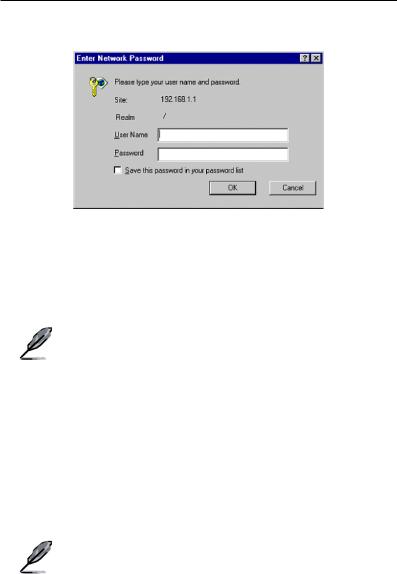
GigaX2024/2048 L2 ManagedSwitch User Manual
This is the factory default IP address of the switch.
A login screen appears, as shown in Figure 7.
Figure 7. Login Screen
Enter your user name and password, and then click OK to enter the Configuration Manager. Use the following defaults the first time you log into this interface:
Default User Name: admin Default Password: (no password)
You can change the password at any time (see section 5.3.1
System Commands).
Note
3.To setup a new IP address, click System, then IP Setup (see Figure 8). Fill in the IP address, network mask and default gateway, then click OK.
4.When the new address is applied to the switch, the browser can no longer update the switch status window or retrieve any page. You need to retype the new IP address in the address/location box, and press <Enter>, then the Web link returns.
5.To enable authentication for Web access, click Administration on the menu list, then select Enabled to start the protection.
6.A login window appears immediately after you click OK. See the figures on the next page.
|
Note that the GigaX 2048 and 2024 models have the same web |
|
interface, except for the front panel image on top of the screen |
Note |
(see figures on the next page). |
|
|
|
The following sections show only one screen image (that of the |
|
GigaX 2048 model) if the screen contents for both models are |
|
the same. Both the GigaX 2048 and 2024 screens are shown |
|
when the screen elements are different. |
10
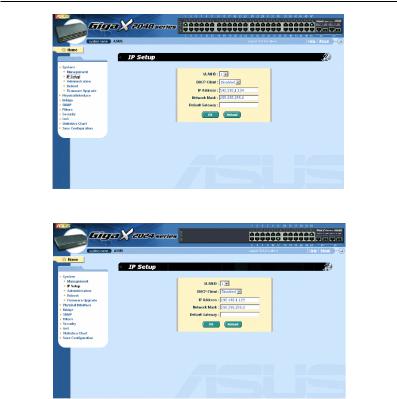
GigaX2024/2048 L2 Managed Switch User Manual
Figure 8.IP Setup (GigaX 2048)
Figure 9.IP Setup (GigaX 2024)
11

GigaX2024/2048 L2 ManagedSwitch User Manual
4 Management with the Web Interface
The switch provides Web pages that allow switch management through the Internet. The program is designed to work best with Microsoft Internet Explorer® 5.5, or later versions with Java® enabled. NOTE: Netscape is not supported.
4.1 Log into Web user interface
1.Open the web browser (IE) on your computer, type the following in the web address (or location) box, and press <Enter>:
http://192.168.1.1
This is the factory default IP address for the switch. A login screen displays as shown in Figure 10.
|
Figure 10. Configuration manager login screen |
|
Log in is not required if you do not enable web access |
Note |
authentication (see section 3.3.2.) |
|
2.Enter your user name and password, then click OK.
Use the following defaults the first time you log into the system. You can change the password at any time through CLI interface (see section 5.3.1 on page 57).
Default User Name: admin Default Password: <no password>
The home page appears each time you log into the program. See Figures 11 and 12).
12
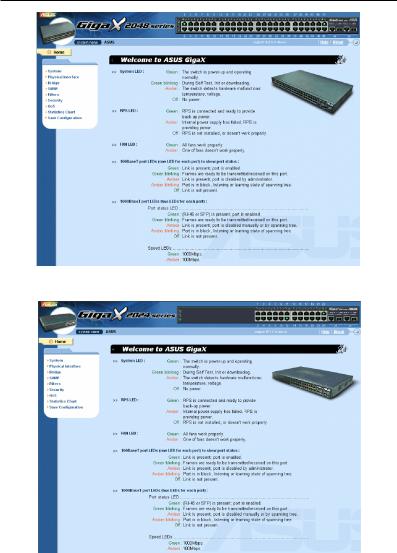
GigaX2024/2048 L2 Managed Switch User Manual
Figure 11. Home page (GigaX 2048)
Figure 12. Home page (GigaX 2024)
13
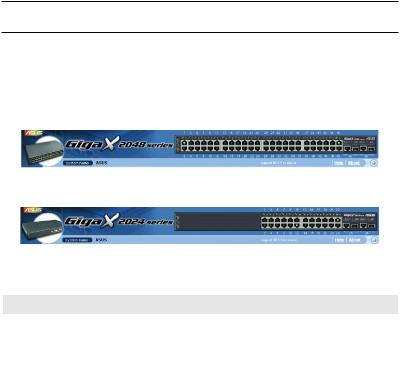
GigaX2024/2048 L2 ManagedSwitch User Manual
4.2 Functional layout
The web-based configuration page consists of three separate frames. The top frame has a switch logo and front panel as shown in Figures 13 and 14. This frame remains on the top of the browser window all the times and updates the LED status periodically. See Table 4 for the LED definitions. See Table 5 for the color status description.
Figure 13. Top frame (GigaX 2048)
|
Figure 14. Top frame (GigaX 2024) |
Table 5. Port color description |
|
|
|
Port Color |
Description |
Green |
Ethernet link is established |
Black |
No Ethernet link |
Amber |
Link is present but port is disabled manually or by spanning tree |
Clicking on the port icon of the switch displays the port configuration in the lower right frame.
The left frame, which is shown in Figure 15, contains all the features available for switch configuration. These features are grouped into categories, e.g. System, Bridge, etc. You can click on any of these to display a specific configuration page.
14
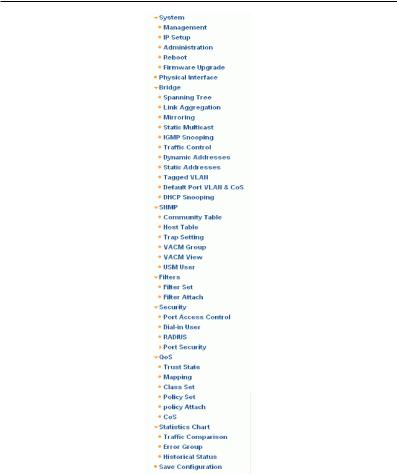
GigaX2024/2048 L2 Managed Switch User Manual
Figure 15. Expanded Menu List
The above frame displays configuration pages or graphics for the statistics. See section 4.3 for details.
4.2.1 Menu navigation tips
•To expand a group of related menus, click on the corresponding group name. The  sign will change to
sign will change to  after expansion.
after expansion.
•To contract a group of related menus: click on the corresponding group name. The  sign will appear next to the group name.
sign will appear next to the group name.
•To open a specific configuration page, click on the desired menu item.
15
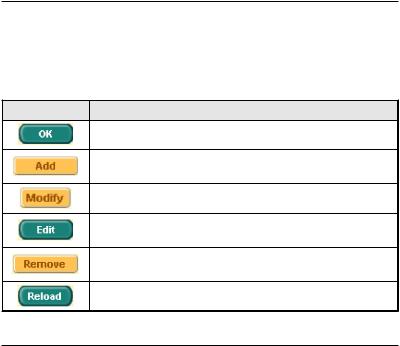
GigaX2024/2048 L2 ManagedSwitch User Manual
4.2.2 Commonly used buttons and icons
The following table describes the function for each button and icon used in the application.
Table 6. Commonly used buttons and icons
Button/Icon Description
Stores any changes you have made on the current page.
Adds the existing configuration to the system, e.g. a static MAC addressorafirewallACLruleandetc.
Modifies an existing entry
Modifies the existing configuration in the system, e.g. a static route or a filterACL rule and etc.
Deletes the selected item, e.g. a static route or a filter ACL rule and etc.
Re-displays the current page with updated statistics or settings.
4.3 System Pages
System pages include management, IP setup, administration, reboot, and firmware update function.
4.3.1 Management
The Management page contains the following information: Model Name: product name
MAC Address: switch MAC address
System Name: user assigned name to identify the system (editable). System Name can not include character ʻ/ʼ.
System Contact (editable). System Contact can not include character ʻ/ʼ. System Location (editable). System Location can not include character ʻ/ʼ.
Click on OK to make the setting effective immediately. Click on Reload to refresh the setting to current value, as shown in Figure 16. To save configuration permanently, please go to Save Configuration page, then click on Save.
16

GigaX2024/2048 L2 Managed Switch User Manual
Figure 16. Management
4.3.2 IP Setup
The switch supports dynamic IP and static IP assignment. Dynamic IP can be got from a DHCP server within the same VLAN. The IP Setup page contains the following editable information:
VLAN ID: Specifies a VLAN ID to system management interface. It is necessary to be within the same VLAN for management usages.
DHCP Client: Enables DHCP to get a dynamic IP address, or disable DHCP to specify a static IP address. The DHCP server must be reachable within the management VLAN.
IP Address: Assigns a static IP address to the switch management interface.
Network Mask
Default Gateway
Click on OK to make the setting effective immediately. Click on Reload to refresh the setting to current value, as shown in Figure 17. To save configuration permanently, please go to Save Configuration page, then click on Save.
Figure 17. IP Setup
17
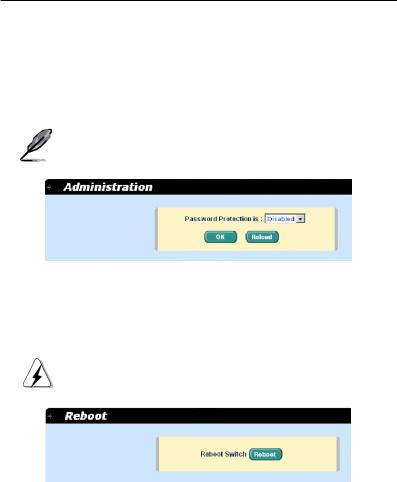
GigaX2024/2048 L2 ManagedSwitch User Manual
4.3.3 Administration
The Administration page allows to enable or disable the password protection for web user authentication. The default setting does not require any authentication.
To save any changes and make it effective immediately, click OK. Use Reload to update the setting, as shown in Figure 18. When you enable the password protection, you have to login again immediately.
You can change the password at any time through the CLI interface.
Note
Figure 18. Administration
4.3.4 Reboot
The Reboot page contains a Reboot button. Clicking the button to reboot the system.
Rebooting the system stops the network traffic and terminates the Web interface connection.
Warning
Figure 19. Reboot
4.3.5 Firmware Upgrade
The Firmware Upgrade and Auto-config page contains the following information: Hardware Version: shows the hardware revision number.
Boot ROM Version: shows the version of the boot code
Firmware Version: shows the current running firmware version. This number renews automatically after firmware update is complete.
18
